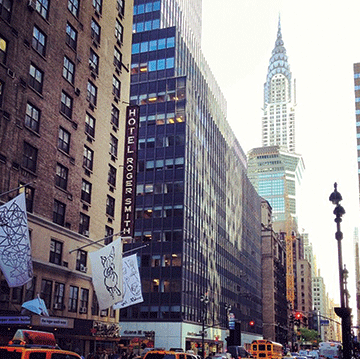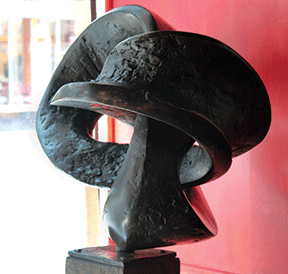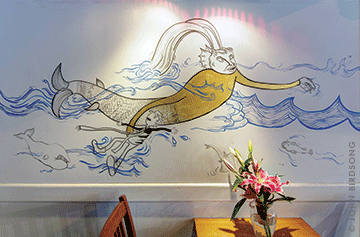
Class of ’69 | At 7 o’clock on a September weeknight, guests were flowing into the private dining room of the Roger Smith Hotel for its annual poetry night. Sitting around a long, rectangular table were distinguished poets like Michael Dickman and Eileen Myles, assorted guests and friends of the hotel—and owner James Knowles GFA’69, who was joined by his wife Sue and two of their grown children: John (the hotel’s head of marketing) and Phoebe.
Over the next few hours, as everyone took turns reciting a poem, guests enjoyed fresh pasta with shrimp, sautéed vegetables, mini pies, and wine—lots and lots of wine. The discussion soon turned to contemporary art, education reform, and what exactly it means to be a poet. Just another normal night for the Manhattan hostelry, one of whose missions is to further the arts of all kinds.
It hosts film screenings, parties that celebrate emerging painters, brown-bag lunches officiated by art dealer Molly Barnes, and a “Classical Music Deconstructed” series, in which musicians play works by well-known composers and lecturers discuss them. Rotating exhibits adorn the lobby, the bar, and the rooftop lounge; Danika Druttman, who spearheads the art program, quips that she puts art in “any space I can get my grubby hands on.” Video art is shown on television channels in each of the 136 guest rooms. The hotel’s three shops exhibit the work of bold fashion designers like Nora Gardner. There’s no requirement that guests be artists or even art lovers, of course, though many are. Plus, all of the events and exhibitions are open to the public.
“It is a hotel known among visual artists as a place that welcomes and encourages creativity, innovation, and community,” says Michael Royce, executive director of the New York Foundation for the Arts. “It plays a very unique role.”
This is exactly the way Knowles, a sculptor himself, wants it.
“I have the idea that Roger Smith should be an institution in the city,” he says, “that it should be like a university in its breadth of subject matter and people.”
The question, he adds, is: “How do you make something that brings tears to your eyes?” He thinks about that for a moment. “Or maybe you don’t do that. You just make something authentic and meaningful.”
Though Knowles studied architecture as an undergraduate at Yale, he soon realized that he was more interested in making something natural and beautiful than functional.

“Architecture is very technical,” he says. “You have to figure out how to work in business and all that.” He came to Penn in 1977 to get his MFA in sculpture, a medium he regards as “simple and clear,” adding: “the purity of architecture is sculpture.”
During his time at Penn, Knowles often walked to the Rodin Museum or the Philadelphia Museum of Art to study the sculptures. He traveled to Paris to visit the foundries Rodin used, and there tried to replicate the French casting system. He formed a close mentorship with the late Neil Welliver, then chair of the Graduate School of Fine Arts and an accomplished landscape painter, who gave him the freedom to explore in this way. When a jury of Penn professors harshly judged one of Knowles’ early works, a set of plastic female figures with “clearly no dress on them,” Welliver stood up and said: “He’s working through it. It’s part of the process, so lay off.”
After more travel and study, he married Sue and settled down in Connecticut, where clients like William F. Buckley, Temple Sinai Synagogue, and the New York Film Festival commissioned him to create large stainless-steel sculptures out of tiny rods and smooth bronze sculptures representing ideas like infinity or fertility. And when his father-in-law died in 1987 and left the hotel to him—the last of a chain of 17 Depression-era urban hotels across the country—he decided to dedicate it to his longstanding love and exploration of art and beauty.

Over time, the hotel narrowed its focus to helping emerging artists. When Danica Novgorodoff, a Brooklyn-based illustrator of comic books and graphic novels, proposed drawing a mural, Druttman gave her a prime piece of real estate: a white wall in the downstairs bar that could be seen by anybody walking down Lexington Avenue.
“It was an experiment,” Novgorodoff says. “I made it up as I went, and it was nice to not have to worry about the hotel not liking it or dictating what to put there.” The Roger Smith also integrates those artists into the larger art world by holding talks where established artists introduce new ones.
Rachel Wolff, a New York-based art writer, editor, and critic, says there are many of these stories. “The hotel has been critical in giving these artists a place to work through their ideas in a public forum,” she says, noting that “many spaces in New York are hesitant to take those kinds of risks with their programming.”
Knowles also pushes guests to get involved with art when they stay at the Roger Smith, securing them invitations to art parties and granting private tours of the exhibits. He drives his staff even harder—starting with the 7 a.m. breakfasts, where they talk about how to make the hotel “shine” with even more beauty. One of those morning brainstorming sessions produced an unlikely fusion of beauty and practicality: a Tesla charger built into one of Knowles’ giant bronze sculptures in front of the hotel.
“I really value having a dynamic art program in my hotel,” says one frequent guest from Sydney, Australia. “It just adds to the New York experience.”
—Alyson Krueger C’07

